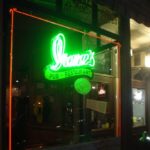 Last night before going to see the Pixies, the siblings and I took advantage of the moment to visit an old friend, Irene’s pub in Ottawa’s Glebe district. Irene’s is a neighbourhood bar which means it is not necessarily the place to take someone on a first date unless you are on a serious testing night-out. If she agrees to go to Irene’s again, she wins. If she suggests going to Irene’s again, you win.
Last night before going to see the Pixies, the siblings and I took advantage of the moment to visit an old friend, Irene’s pub in Ottawa’s Glebe district. Irene’s is a neighbourhood bar which means it is not necessarily the place to take someone on a first date unless you are on a serious testing night-out. If she agrees to go to Irene’s again, she wins. If she suggests going to Irene’s again, you win.
Month: November 2004
Morning Read
Somedays I am reluctant to write a post. Sometimes it is because the caffine has yet to organize my mind. Sometimes it is because there is no news. Sometimes. like today, it is because I do not want to see something slip off the front page above the fold. That something is the bowl of Mr. Tran’s excellent Thai noodle soup I had for lunch yesterday. I am confirming all of Pavlov’s experiments this morning every time I go past it. Nonetheless, you have needs. So, here are some good reads from elsewhere:
- Junk Store Cowgirl writes about events during a western New York military campaign in 1779.
- Through Rob1 (I have delinked all the other Robs but still like to call him Rob1), I have come across Dina’s site, a well-written blog from India.
- Alfons in the Netherlands is thinking about tolerance.
- Living in Dryden continues its comprehensive description of one small US town and does so so well I am starting to think I am actually a shut-in there as long as I leave the TV on channel 5 with its unending ads for apparently unlimited Fuccillo car dealerships of north and central NYS.
- Ian relives the pre-punk, pre-disco world of being an elementary school kid in the early 1970s home with the radio.
That should help take your mind off Thai noodle soup…Thai noodle soup…Thai noodle soup…Thai noodle soup…Thai noodle soup…
Cambodian Village

The best thing for a frozen day. Not fancy. Menu on the wall and you drink out of styrofoam. Chef Tran was trained by Mr. Vann I think. Mr. Tran makes a Western Style that is not so explosively hot…though I suspect Chef Vann’s up at Cambodiana is more authentic. Both are the best.
Privacy Through Walls
A few years ago now, I wrote a thesis about a type of surveillance and included a quote from a 1928 dissent in the Supreme Court of the United
Justice case Olmstead v. U.S. 277 U.S. 438 (1928):
Ways may some day be developed by which the Government, without removing papers from secret drawers, can reproduce them in Court, and by which it will be enabled to expose a jury to the most intimate occurrences of the home.
…
…as time works, subtler and more far-reaching means of invading privacy will become available to the government. The progress of science in furnishing the government with the means of espionage is not likely to stop with wiretapping. Advances in the psychic and related sciences may bring means of exploring beliefs, thoughts and emotions.
The Supreme Court of Canada recently reviewed a case, R. v. Tessling, similar at least in the use of such new intrusive technologies:
The RCMP used an airplane equipped with a Forward Looking Infra-Red (“FLIR”) camera to overfly properties owned by the accused. FLIR technology records images of thermal energy or heat radiating from a building. It cannot, at this stage of its development, determine the nature of the source of heat within the building or “see” through the external surfaces of a building. The RCMP were able to obtain a search warrant for the accused’s home based on the results of the FLIR image coupled with information supplied by two informants. In the house, the RCMP found a large quantity of marijuana and several guns. The accused was charged with a variety of drug and weapons offences.
The headnote to the Tessling ruling in summarizing the Court’s ruling states that the accused had a privacy interest in the activities taking place in his home and it may be presumed that he had a subjective expectation of privacy in such activities to the extent they were the subject matter of the search. However, everything shown in the heat-generated photograph exists on the external surfaces of the building and, in that sense, it recorded only information exposed to the public. Although the information about the distribution of the heat was not visible to the naked eye, the heat profile did not expose any intimate details of the accused’s lifestyle or part of his core biographical data. It only showed that some of the activities in the house generate heat. Thus, the Court held, when one considers the “totality of the circumstances”, the use of the technology did not intrude on the reasonable sphere of privacy of the accused.
It is interesting to note that the ruling in 2004 was about a fact situation in 1999 and 1999 technology. Despite this delay between the facts before it and its own ruling, the Supreme Court of Canada stated in Tessling:
In my view, with respect, the reasonableness line has to be determined by looking at the information generated by existing FLIR technology, and then evaluating its impact on a reasonable privacy interest. If, as expected, the capability of FLIR and other technologies will improve and the nature and quality of the information hereafter changes, it will be a different case, and the courts will have to deal with its privacy implications at that time in light of the facts as they then exist.
So what can Forward Looking Infra-Red see now? Ratheon sell it to the US Air Force promoting these features. SgmaTel made this press release last month. The US Army Research Laboratory announced this earlier this year. Not exactly a simple infra-red camera hanging from a police helicopter now. Smart image processing is occuring.
As was stated in the dissent in Olmstead,
…the makers of the US Constitution understood the need to secure conditions favorable to the pursuit of happiness, and the protections guaranteed by this are much broader in scope, and include the right to life and an inviolate personality — the right to be left alone — the most comprehensive of rights and the right most valued by civilized men… It does not matter if the target of government intrusion is a confirmed criminal. If the government becomes a lawbreaker, it breeds contempt for law.
This was written by Justice Louis Brandeis and conccurred with by Justice Oliver Wendle Holmes, two fairly strong swimmers. Do you believe that this is a relevant statement regarding the limits of surveillance given the advance of technology? Does a court that reviews the facts of a case five years after the fact inspire you with great confidence that the law has a good handle on advancing surveillance technologies and your privacy?
Firefox 1.0 Released
My pals at silverorange have participated in the development of the open
source browser Firefox and today is its 1.0 release. Go
read Steve about the big day and then go download it.
Yes, I called it Foxfire.
The Government Store, Canada
When I was a kid old O.H. Armstrong in our church called it the “Government Store”. In the South Shore of Nova Scotia apparently it is called the “Power House”. What ever you call them, there is a little left over from prohibition in every province in the country – the need to control…which also leads to the inability to shop around much. We are lucky here in eastern Ontario with the shops of Quebec and New York state not that far away, so that an hour and a half or two gets you into another world with another set of wacky regulations. If you are looking for something different when you travel, you can plan ahead with the web…but just don’t get too depressed from what you read:
- Newfoundland
- Nova Scotia
- Prince Edward Island
- New Brunswick
- Quebec
- Ontario
- Manitoba
- Saskatchewan
- Alberta
- British Coumbia
What do you learn from looking at these sites? Don’t go beer hunting in PEI right off the top: no selection, six imports three of which are Heineken, Becks and Stella – mmm, macro-industrial North Sea lager. Quebec has very interesting beers, allows you to find out if a bottle is actually in your shop and shop on-line but if you are in a northern village you have to let the local authorities know what you have ordered. Newfoundland calls beer from New Brunswick imported. Alberta has privatized the shops in 1993 and has since only regulated but still they are left, according to the Bar Towel in 2002, with limited selection.
So – what do you do with a country that cannot organize itself better than a cornerstore in a suburb of a small US city or a pub in Halifax
Corporate Deadbeatism
Sensitive readers will recognize my advocacy of respect for reasonable and
lawful taxation as a cornerstone of the new
morality. It is with that purpose I suggest that readers have a look at this
story wherein billions have gone unpaid all in the name of smuggling coffin
nails. Next time you wonder why there is a shortage of money for your favorite
public project, ask a shareholder of JTI-MacDonald, a subsidiary of Japan
Tobacco. While respect for the processes of the court is another cornerstone,
one has to ask if the taxes have gone unpaid, who else could be responsible? Is
this a case of res ipsa locuitur loquitur?
Book Review: Terry Foster, Beer Writer
 Terry Foster is one of my favorite beer writers and the most interesting thing about him as a beer writer these days is he does not have a website. I don’t know how you can exist without a website these days. How else will all the Google bots be able to share your daily musings. Google bots…bots…Google…[Ed.: Giving author a good shake] Oh, right…there is no money and no audience in a website and others are doing it already so why bother. Good point.
Terry Foster is one of my favorite beer writers and the most interesting thing about him as a beer writer these days is he does not have a website. I don’t know how you can exist without a website these days. How else will all the Google bots be able to share your daily musings. Google bots…bots…Google…[Ed.: Giving author a good shake] Oh, right…there is no money and no audience in a website and others are doing it already so why bother. Good point.
I encountered Terry Foster as a home brewer. He is the author titles #1 and #5 in the Classic Beer Style Series published by the Association of Brewers, a US company promoting the homebrew industry. Pale Ale is the first in the series and Poer the fifth. These books are now over a decade old but recently I noticed that Foster has been writing articles for Brew Your Own magazine regularly as well. These sorts of writings as well as my years of one hundred gallons of output have convinced me that the appreaciation of beer is uniquely advanced by learning about and undertaking its production.
A number of the early homebrewing authors started me on that path and it would be my suggestion that Terry Foster is a continuation of that line of thinkers and writers about beer. In April 1963, month of my birth, the British Government ended the taxation of homebrewing under the Inland Revenue Act of 1880 which required records to be kept and a one ound license to be paid. As W.H.T. Tayleur states in his text Home Brewing & Wine-Making (Penguin, 1973) at page 15:
This legislation reminaed in force for eighty-three years, but although at first many thousands of private brewing licences were taken out the number of home brewers steadily declined over the years until by the middle of this century, and after shortages of the necessary ingredients caused by two world wars, hardly any of the few that were left bothered to take out licences.
By removing the need to license, the government created an industry and changed brewing, to my mind, for two reasons. First, self-trained home brewers became self-trained micro-brewers as the opportunities to make money with the skill became apparent. Second, consumers gained access to well-made home brews which were much cheaper and much tastier than the standardized industrial kegged beer the 1960s were foisting upon people. Without men like the 1960s authors C.J.J. Berry and Ken Shales as well as David Line in the 1970s, all writing primarily through Amateur Winemaker Publications, many a brew-pub or craft brewery on both sides of the atlantic would simply not exist.
C.J.J. Berry, Ken Shales and David Line
Foster is perhaps the last of this tradition of British home brewing writers – and not just because his slicked back hair, styled in common cause with them. His two books, Pale Ale and Porter each provide a history of the style, a description of the elements, a guide to making them and a discussion of the commercial examples. Like those earlier authors he provides the context of the style and also deconstructs the mystery of how the brews can be made. Context and technique are two things modern industrial commercial brewers would like to shield from their customers – they more they were to know about what is out there and what it costs, the less likely the concept of brand loyalty might hold the customer.
Foster’s recent articles in Brew Your Own magazine continue this tradition. I have copies of the following articles:
“Pale Ale”, BYO September 2003, page 30.
“Old Ales”, BYO, September 2004, page 27.
“Anchors Away – A History of Malt Extract: Part 1”, BYO October 2004, page 30.
“Let’s Get Rid of the Water – A History of Malt Extract: Part 2”, BYO, November 2004, page 34.
As is the mandate of the magazine, Foster provides context and technique, showing how historical styles can be recreated with confidence. For example, in the third article he discusses how the British Navy invented malt extract in an effort to provide beer to sailors as a necessary food while in the fourth he describes how later extracts were used to avoid the stupidities of prohibition.
Foster’s style is attractive in that he is a plain speaker. In a world of where reputation and brand is all important, he can write of Yuengling’s Pottsville Porter:
…this is in some sense a classic porter, although it is bottom-fermented. Unfortunately, although it has many adherents, I am not one of them as I find it a little disappointing.
Not only is he not looking for the next PR opportunity when he writes, he is a bit folksy while also well researched. He is a trained chemist and has been a professional brewer for over 40 years, according to his BYO bio. He is interested and as a result interesting.







